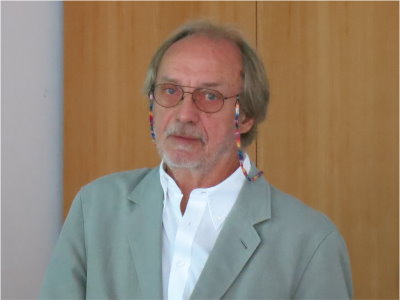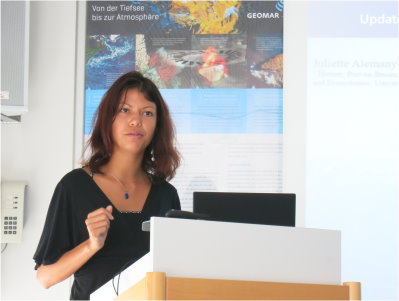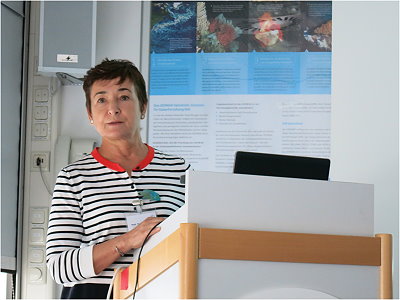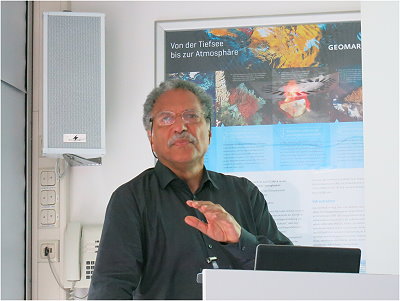 Cada año, el consorcio internacional que mantiene a FishBase y otros sistemas de información global sobre la biodiversidad y el uso humano del océano se reúnen para evaluar el progreso y los nuevos desafíos. Cada vez, un simposio de ciencia pública muestra avances en el uso de los sistemas de información para la conservación y el uso sostenible de los recursos acuáticos. El consorcio y simposio de este año se celebraron en GEOMAR en Kiel, Alemania.
Cada año, el consorcio internacional que mantiene a FishBase y otros sistemas de información global sobre la biodiversidad y el uso humano del océano se reúnen para evaluar el progreso y los nuevos desafíos. Cada vez, un simposio de ciencia pública muestra avances en el uso de los sistemas de información para la conservación y el uso sostenible de los recursos acuáticos. El consorcio y simposio de este año se celebraron en GEOMAR en Kiel, Alemania.
The global information system on all fish in the world, FishBase, covers currently some 34,000 species accessible e.g. through more than 300,000 common names in 385 languages. FishBase provides pictures, biological information and many parameters crucial for fisheries managers, conservationists, aquarists and many others. The scientific quality is ensured by an Consortium of two international and 10 scientific organisations from around the world. The Consortium also oversees related information platforms, such as SeaLifeBase (all non-fish organism in the ocean), Aquamaps (geographical distribution maps of organisms in marine and freshwater environments) and others.
 From 3 to 7 September the Consortium met at GEOMAR, one of its founding members. The latest progress in the science underpinning the information systems was presented at a public FishBase Symposium at GEOMAR on 4 September, which triggered a lot of interest and discussion. The Consortium is proud to serve more than half a million unique visitors per month while also working on improving the user-experience on hand-held devices, which are now more common than classical computers.
From 3 to 7 September the Consortium met at GEOMAR, one of its founding members. The latest progress in the science underpinning the information systems was presented at a public FishBase Symposium at GEOMAR on 4 September, which triggered a lot of interest and discussion. The Consortium is proud to serve more than half a million unique visitors per month while also working on improving the user-experience on hand-held devices, which are now more common than classical computers.
The dire state of large parts of marine and freshwater fish biodiversity and the fact that most sharks and large tuna and bill fishes are now on the IUCN Redlists of threatened or near threatened species makes the free services FishBase provides all the more important.
The first two presentations by Rainer Froese of GEOMAR and Cornelia E Nauen of Mundus maris centred on the importance of fish size for management and awareness raising among a wide range of stakeholders so as to promote healthy and productive fish stocks and marine ecosystems.
Fish rulers with indications of the minimum size (length) at which fish species reproduce in different regions can be a useful tool to engage more professionals and ordinary citizens in preventing the particularly insidious forms of massive fishing of juveniles before they have grown to maturity.
 During the discussion, Prof. Yvonne Sadovy of Hong Kong University drew attention to a more recent form of overfishing - targeting particularly rare, and often threatened, species, particularly in the live fish trade for Asian up-market demand. Click here for the slides of Cornelia's talk.
During the discussion, Prof. Yvonne Sadovy of Hong Kong University drew attention to a more recent form of overfishing - targeting particularly rare, and often threatened, species, particularly in the live fish trade for Asian up-market demand. Click here for the slides of Cornelia's talk.
Her own talk elaborated on that threat in relation to spawning aggregations of reef fish, that are an easy target for fisheries, but must, by all means be protected to ensure the continued existence of healthy populations.
As such life cycle behaviours are not systematically researched, there is a lack of awareness about where and when protection of the species concerned is essential.
Prof. Daniel Pauly of the Institute of Oceans and Fisheries of the University of British Columbia, Vancouver, Canada spoke about the role of dissolved oxygen and gill surface area for the growth limitations of gill breathing organisms. As water is much denser than air, gas exchange is much harder for organisms living in water than those breathing air on land. As gill surface can not grow at the same rate as body volume, growth must stop at some stage.
 Daniel then explored several cases of "odd fishes" which seem to break that rule, e.g. because they grow exceptionally big.
Daniel then explored several cases of "odd fishes" which seem to break that rule, e.g. because they grow exceptionally big.
However, each case investigated in detail actually confirms the underlying principle -
- be it the Giant Manta (Mobula birostris), where gills occupy most of the body or
- be it the Sunfish (Mola mola), which can grow up to around two tonnes. It turns out that most of the body mass of the Sunfish is composed of an inert gelatinous substance, which does not require constant oxygen supply which provide buoyancy for its sluggish lifestyle.
It was an excellent illustration that good science, rather than ad hoc explanations allow to explain the phenomena observed in nature and provide great capacity of anticipation.
Colleagues of GEOMAR also illustrated exciting scientific advancements e.g. in plankton and macro-ecological research and what they may mean for addressing global change.









